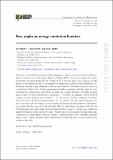New angles on energy correlation functions
Author(s)
Moult, Ian James; Necib, Lina; Thaler, Jesse
Download13130_2016_Article_5284.pdf (2.418Mb)
PUBLISHER_CC
Publisher with Creative Commons License
Creative Commons Attribution
Terms of use
Metadata
Show full item recordAbstract
Jet substructure observables, designed to identify specific features within jets, play an essential role at the Large Hadron Collider (LHC), both for searching for signals beyond the Standard Model and for testing QCD in extreme phase space regions. In this paper, we systematically study the structure of infrared and collinear safe substructure observables, defining a generalization of the energy correlation functions to probe n-particle correlations within a jet. These generalized correlators provide a flexible basis for constructing new substructure observables optimized for specific purposes. Focusing on three major targets of the jet substructure community — boosted top tagging, boosted W/Z/H tagging, and quark/gluon discrimination — we use power-counting techniques to identify three new series of powerful discriminants: M[subscript ɩ], N[subscript ɩ], and U[subscript ɩ]. The M[subscript ɩ] series is designed for use on groomed jets, providing a novel example of observables with improved discrimination power after the removal of soft radiation. The N[subscript ɩ] series behave parametrically like the N -subjettiness ratio observables, but are defined without respect to subjet axes, exhibiting improved behavior in the unresolved limit. Finally, the U[subscript ɩ] series improves quark/gluon discrimination by using higher-point correlators to simultaneously probe multiple emissions within a jet. Taken together, these observables broaden the scope for jet substructure studies at the LHC.
Date issued
2016-12Department
Massachusetts Institute of Technology. Department of PhysicsJournal
Journal of High Energy Physics
Publisher
Springer-Verlag/SISSA
Citation
Moult, Ian, Lina Necib and Jesse Thaler. "New angles on energy correlation functions." Journal of High Energy Physics, no. 153, 2016, pp. 1-72.
Version: Final published version
ISSN
1029-8479
1126-6708